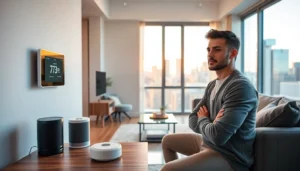Table of Contents
ToggleImagine a world where your coffee brews itself, your vacuum cleans without you lifting a finger, and an AI is managing your schedule, sounds like a sci-fi movie, right? Well, welcome to the future. Automated devices are not just a luxury anymore: they’re becoming essential. As they leap from the pages of books and into our homes, they’re challenging the way we live, work, and even relax. Ready for a deep jump into how these gadgets are transforming our everyday lives? Let’s get started.
Understanding Automated Devices

Automated devices are tech-savvy machines designed to perform tasks with minimal human intervention. At their core, these devices are built upon algorithms and sensors that allow them to process information and make decisions. Think of them as the diligent helpers you didn’t know you needed. From smart thermostats adjusting the temperature based on your preferences to autonomous drones delivering packages, automated devices streamline processes, increase efficiency, and often enhance safety.
Types of Automated Devices
There’s a smorgasbord of automated devices out there, each tailored to fit different needs.
Home Automation
Smart home technology has taken off. Devices like smart speakers, lights, and security cameras allow homeowners to control multiple components through voice commands or apps.
Industrial Automation
Factories use automated machinery to enhance production efficiency. Robotic arms, conveyor belts, and integrated software help processes that once required large workforces.
Healthcare Innovations
In healthcare, automated devices monitor patients, dispense medication, and even assist in surgeries, significantly reducing human error.
Automotive Advancements
Driver-assistance systems and self-driving cars are moving toward being the norm, changing how people perceive vehicle safety.
Applications of Automated Devices in Everyday Life
Automated devices have snuck into every corner of daily life, simplifying tasks and improving efficiency.
Smart Kitchens
Imagine your refrigerator alerting you when you’re low on groceries or an oven that preheats itself based on the recipe you select. These are just a few examples of how kitchen automation is changing meal prep.
Personal Assistants
Devices like Amazon Echo or Google Home respond to voice commands, playing music, setting reminders, or even ordering takeout, all with a bit of charm.
Health Monitoring
Wearable devices track everything from footsteps to heart rates. They gather health data and provide insights, encouraging better lifestyle choices.
Benefits of Automated Devices
The advantages of integration of automated devices are hard to ignore.
Efficiency and Productivity
Automated devices save time. They handle mundane tasks, allowing individuals to focus on more complex challenges.
Accuracy
Humans make mistakes: machines don’t. Automation minimizes errors in data entry, manufacturing, and even in navigation.
Improved Quality of Life
From convenience in daily tasks to better health management, these devices enhance the overall quality of life.
Challenges and Concerns
Even though the numerous benefits, automated devices come with their set of concerns.
Job Displacement
Automation often leads to job loss in certain sectors. As robots and machines take over tasks, the workforce must adapt, something that not everyone is ready for.
Security Risks
Smart devices can be prone to hacking, creating vulnerabilities for users. As automation becomes widespread, safeguarding personal data should be a top priority.
Dependency Issues
Relying too much on technology can lead to a decline in essential life skills. Remembering phone numbers, navigating without GPS, or cooking without a recipe can take a backseat as reliance grows.
The Future of Automation
The trajectory of automation suggests a future filled with even smarter devices.
AI Integration
As artificial intelligence continues to evolve, devices will become not only automated but also intelligent, learning preferences and optimizing routines automatically.
Greater Accessibility
Future automated devices are likely to focus on inclusivity, catering to those with disabilities or older adults, ensuring everyone benefits from technological advancements.
Sustainability Efforts
Many new devices are designed with sustainability in mind, reducing energy consumption, and optimizing resource use, contributing to eco-friendly initiatives.






